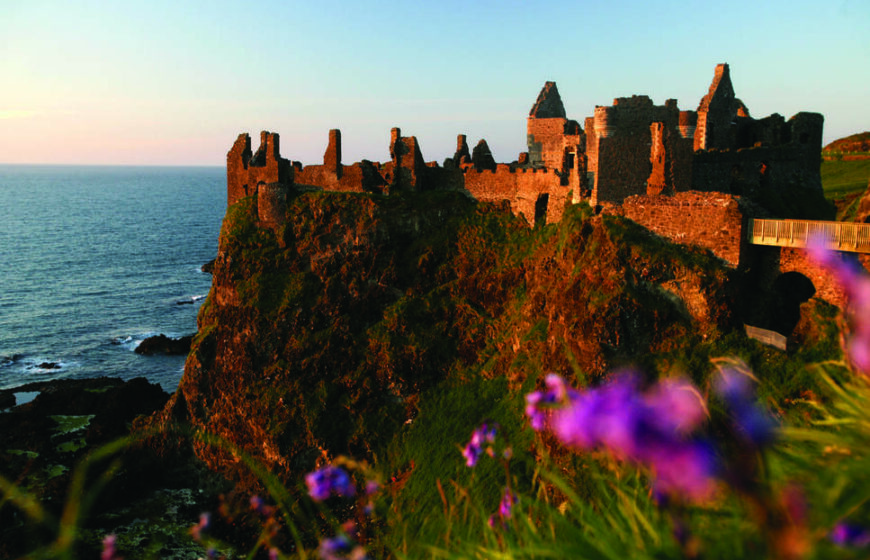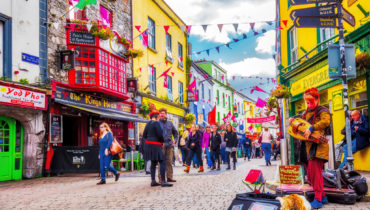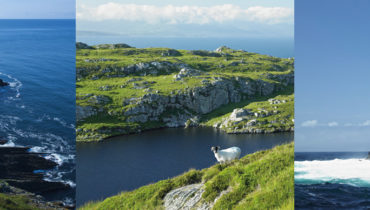Throughout the centuries, Ireland has proved irresistible to the wealthy and powerful, from Norman Knights to eccentric aristocrats. Their castles still dot the beautiful Irish landscape today. From Medieval marvels, to elegant family homes and dramatic ruins, here are some of the Island of Ireland’s remarkable castles. Contact us now to book and plan your dream vacation to Ireland in 2021
Erected in the early thirteenth century on the site of a Viking settlement, Dublin Castle served for centuries as the headquarters of English, and later British, administration in Ireland. In 1922, following Ireland’s independence, Dublin Castle was handed over to the new Irish government. It is now a major government complex and a key tourist attraction. See the state apartments, the Chapel Royal, the Undercroft and the beautiful grounds, beneath which lies the “dubh linn”, or dark pool, that gave the city its name. Enjoy a walk through the beautiful gardens on your next visit.
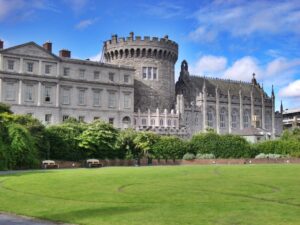
The magnificent medieval castle with a dramatic 800 year heritage.King Henry II gifted Richard Talbot the lands and harbour of Malahide for his services to the crown in 1185. From that point on, the Talbot family became intertwined with Malahide’s history and development. The original stronghold built on the lands was a wooden fortress but this was eventually superseded by a stone structure on the site of the current Malahide Castle. Over the centuries, rooms and fortifications were added, modified and strengthened until the castle took on its current form. Generations of the Talbot family have called Malahide Castle home. Hear their stories, explore the private rooms and collections, and discover the central part this castle played in Irish political and social life on a guided tour.
Although referred to as a Castle, the residence at Ardgillan is a large country-styled house with castellated embellishments. Originally named “Prospect House”, the central section was built in 1738 by Robert Taylor. His great grandfather was Thomas Taylor who first came to Ireland to work with the Irish Commission, that was to value the land confiscated following Cromwell’s campaign in Ireland. With the addition of the Ardgillan property, the Taylors occupied much land and stature in Ireland during this time. Initially the site was heavily wooded, the name Ardgillan being derived from the Irish “Ard Choill” meaning High Wood. It was cleared out by service soldiers and itinerant workers in return for one penny a day, sleeping accommodation and one meal. The Castle has now been restored and the ground floor rooms and kitchens are open to visitors for guided tours.
One of the real joys of a visit to Belfast Castle, a solid, 19th century Scots baronial pile, is the view. From its lofty position on Cave Hill, a local landmark named for the five caves located on the side of its cliffs, you get the most fantastic views over the city and Belfast Lough. When you’ve looked your fill, head to the offbeat Cat Garden, where nine replica cats hide in plain sight, disguised as everything from shrubs to sculptures.

The iconic ruin of Dunluce Castle bears witness to a long and tumultuous history. First built on the dramatic coastal cliffs of north County Antrim by the MacQuillan family around 1500, the earliest written record of the castle was in 1513. It was seized by the ambitious MacDonnell clan in the 1550s, who set about stamping their mark on the building under the leadership of the famous warrior chieftain Sorely Boy MacDonnell during an era of violence, intrigue and rebellion.
In the 17th century Dunluce was the seat of the earls of Antrim and saw the establishment of a small town in 1608. You can explore the findings of archaeological digs within the cobbled streets and stone merchants’ houses of the long-abandoned Dunluce Town. The dramatic history of Dunluce is matched by tales of a banshee and how the castle kitchens fell into the sea one stormy night in 1639. It was enough, apparently, to inspire CS Lewis when he was inventing the royal castle of Cair Paravel in his Chronicles of Narnia.
ENNISKILLEN CASTLE, Co Fermanagh
From any angle, Enniskillen Castle is big, but seen from the waters of the River Erne, where it sits right at the water’s edge, it looks dauntingly enormous. No one is quite sure when it was built, but chronicles suggest the 1420s. The turrets and solid walls have guarded the town for centuries, and have been a tempting stronghold for invaders. Nowadays, appropriately, it houses two museums: Fermanagh County Museum and The Inniskillings Museum. The Fermanagh County Museum tells the story of this region from ancient times, while the Inniskillings Museum offers weapons, uniforms and military equipment from the 17th century.
It’s not just Norman invaders who built homes to impress others. An Irish-born speculator, John George Adair, made a fortune in the US and returned to build the remote, Balmoral-style idyll of Glenveagh Castle near the Derryveagh Mountains in the late 19th century. His wife designed the beautiful gardens, and a later owner, wealthy Irish-American Henry McIlhenny, not only added to the castle but invited some of Hollywood’s biggest stars to come and stay, including Charlie Chaplin and Greta Garbo. The setting is breathtaking – 40,000 acres of glens, mountains and woods – and there’s even a herd of deer wandering the grounds. Visitors can get the shuttle bus in from the visitor center and soak up the glamour.
KING JOHN’S CASTLE, Co. Limerick
With its huge stone walls and round towers, the hulking mass of King John’s Castle dominates the medieval heart of Limerick city. Its location was first chosen by Vikings in 922, before King John, brother of Richard the Lionheart (and well-known villain from many a Robin Hood tale), had another castle built in 1197. Many of the original features still stand, along with centuries of additions and repairs. In the courtyard there are reconstructions of a medieval campaign tent and a 17th century siege (the castle got badly knocked about in the Siege of Limerick in 1642). It’s an atmospheric spot right in the heart of Limerick City, and not just for history fans.
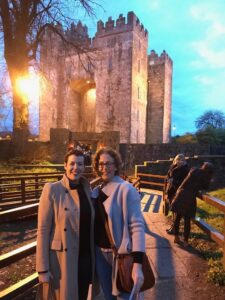
For full-on and authentic reconstructions of times past, visit Bunratty Castle in Co Clare. There were earlier structures built on this site, but the current castle dates back to 1425 and has been meticulously restored with tapestries and furniture that breathe life into its history. Bunratty Castle and its lands were granted to various Plantation families, the last of whom was the Studdart family. They left the castle in 1804 (allowing it to fall into disrepair), to reside in the more comfortable and modern Bunratty House, which is open to the public in the grounds of the Folk Park. Book in for one of the medieval banquets held in the evenings and live like a medieval lord or lady for the night.
Blarney Castle, as viewed by the visitor today, is the third to have been erected on this site. The first building in the tenth century was a wooden structure. Around 1210 A.D. this was replaced by a stone structure which had the entrance some twenty feet above the ground on the north face. This building was demolished for foundations. In 1446 the third fortress was built by Dermot McCarthy, King of Munster of which the keep still remains standing.
Over the last few hundred years, millions have flocked to Blarney making it a world landmark and one of Ireland’s greatest treasures. Now that might have something to do with the Blarney Stone, the legendary Stone of Eloquence, found at the top of our tower. Kiss it and you’ll never again be lost for words.
If it’s invaders you’re worried about, take a look at Cahir Castle. It is superbly designed for defense, seated on a great platform of rock that could withstand just about any onslaught, and did. In fact, it has only been captured three times in its history, which goes back to the 13th century and is inextricably linked with the all-powerful Butler family. There are guided tours and a film show describing its history, but just walking around it gives a mighty sense of the past.
Looking out over the River Nore, Kilkenny Castle is right in the heart of Kilkenny city. The inhabitants busily go about their day in streets that come right up to the walls. The city still has strong sense of its medieval past, with narrow, friendly streets and historic buildings still in use. Parts of the 13th century castle still stand, but have been integrated into a solid, functioning whole that belonged for 600 years to the Butler family before it was sold to the people of Kilkenny for the princely sum of £50. Now small, artistic businesses and galleries flourish within its walls and yards.

The castellated bulk of Birr Castle houses a fascinating family – the Earls of Rosse. Over the centuries their passions – for astronomy, technology, science and horticulture – have been indulged and shared with the world. First stop is the Leviathan, the huge telescope built in the 1840s that was for a long time the biggest in the world. The earl’s wife, meanwhile, was a pioneering photographer and their son experimented with electricity. Their interests are honored in the Science Centre. Later generations were gardeners, creating the enchanting grounds that still lure visitors with rare plants, a lake, fernery and formal gardens.
Trim Castle is the largest, best-preserved & most impressive Anglo-Norman castle in Ireland. Construction began c 1176 and it took over 30 years to complete! Built by a legendary lord with a bad reputation (didn’t they all!!), it’s construction was a statement of power,a reminder to the native Irish that the Anglo Norman invaders were here to stay! The castle takes pride of place on the banks of the river Boyne in Co.Meath and overlooks the historic town of Trim. The Castle has played many roles, including prison, family home and film set – Mel Gibson filmed Braveheart here in the 1990s. Visits into the keep are by guided tour only but you can wander the lush surroundings at your leisure and enjoy the idyllic riverside setting.

